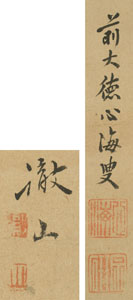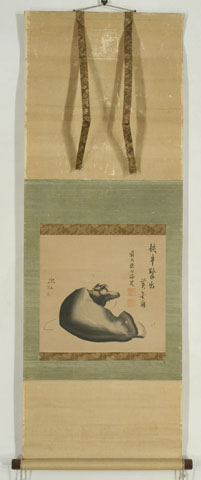Shijô
The iron oxSigned: Tetsuzan, Shinkai Sôken shû
Seals: Tetsuzan, Shinkai Sôken
Technique: sumi on paper 27,5 x 29,6
Mounting: green raw silk and beige silk 107 x 37,4
Condition: a little soiled, creased, aged, otherwise good
The inscription reads: 鉄牛擎出黄金角, Tetsugyû sasageidasu ôgon no tsuno.
The iron ox lifts up and shows its golden horns. -> Glorious splendor. A metaphor for an outstanding disciple emerging. (After meeting with one's true nature, one can make the start to “walk the Way”.)(ref. Lewis 7-278)
A line from the Butsukan Zenji goroku, 仏鑑禅師語録, Annotations by the Chinese Zen teacher Wuzhun Shifan (Bujun Shiban) 無準師範(1177-1249).
Tetsuzan, the son of Mori Shûhô (1738-1823), was born in Kyoto and adopted by his uncle Mori Sosen (1747-1821). He studied with Õkyo (1733-1795) and became one of his ten best pupils. He was related with Õkyo's successor Õzui, by marrying the sister of Õzui's wife. Later he moved to Osaka and became in the service of the Hosokawa family of the Kumamoto fief in Higo Province and allegedly to teach his uncle the Maruyama style. Like Watanabe Nangaku (1755-1839) before him Tetsuzan went to Edo to take more Maruyama school to the Kantô region. Closely following his uncle's style he started a new Mori school. Skilfully rendered animals are often the subjects of his (excellent) paintings. (Roberts)
Reference:
Roberts p. 177
Araki p. 2502
Hillier pp. 258-262
Shinkai Sôken, 410 gen. abbot of the Daitokuji. He was born in Izumi
Reference:
Moog p. 407)
Price: ON REQUEST

